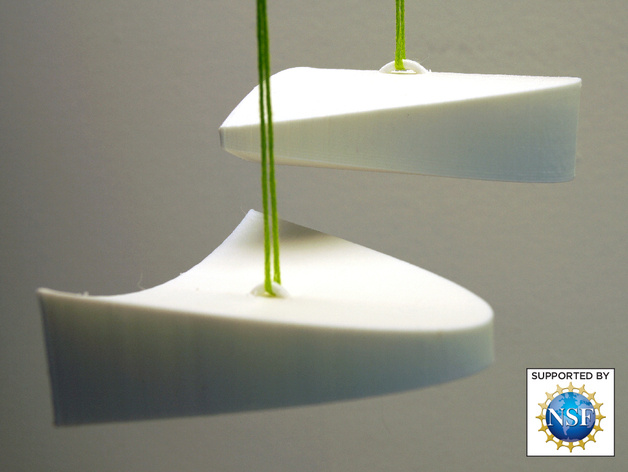
Center of mass manipulatives for calculus classes
thingiverse
Calculus classes often learn how to compute the center of mass of a thin plate with varying density. But how can you check that these computations are actually right? It's hard to actually get an example object made precisely enough to verify that the center of mass is in the right place... unless you have access to a 3d printer! This thing is a pair of thin plates with quadratic density functions and marked centers of mass so that you can do the calculation with your class and demonstrate that the math is correct by balancing the print on a string or on your fingertip. This material is based upon work supported by the National Science Foundation under DUE-12-45540, 'Motivating First-Year Calculus with Robotics'. For more information about this program, see my webpage. Instructions These are manipulatives for a classroom demonstration of calculating center of mass in a calculus class. Each is a plate in the shape of the area under the parabola 8 - x^2/2 (in cm). The thickness of each plate varies with x to simulate a varying density function: the convex one has "density" given by 5/4 - x^2/16 and the concave one has "density" 1/2 + x^2/16. I'll let you work out the center of mass yourself (honestly, I worry that your students might find this page), but each model has a little loop at the center of mass so that you can suspend it and see that it hangs flat, and a little detent on the bottom face so that you can balance it on your fingertip. These dimensions work well with a classroom document camera-- just remember that if you print in white, you'll probably want to bring a sheet of dark paper to put down on the camera bed to provide contrast. I suggest that you also bring a ruler (marked in cm) so that you can measure the coordinates of the center of mass. You might think that the infill would mess up the center of mass, but it doesn't seem to. I printed at 50% infill on a 5th gen MakerBot, and these balanced quite well. 100% would probably be a little better if you want to spend the filament and the printing time. Or you could experiment with making a hollow version and filling it with hot glue. I included the original Rhino files (.3dm format) in case anyone wants to do a remix which tries this.
With this file you will be able to print Center of mass manipulatives for calculus classes with your 3D printer. Click on the button and save the file on your computer to work, edit or customize your design. You can also find more 3D designs for printers on Center of mass manipulatives for calculus classes.
